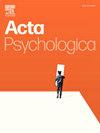Effects of subjective stress levels on learning effectiveness in high-fidelity simulation among healthcare workers
IF 2.7
4区 心理学
Q2 PSYCHOLOGY, EXPERIMENTAL
引用次数: 0
Abstract
Background
Appropriate stress reportedly influences memory gains. However, stress levels may vary across individuals and may lead to changes in vital signs as a physiological response induced by endogenous hormone secretion. The aim of this study was to evaluate the impact of high-fidelity simulation (HFS) training on cognitive performance using Perceived Stress Scale (PSS) scores as a subjective stress indicator and vital sign measurements as an objective stress indicator during Neonatal Resuscitation Program training.
Materials and methods
This study was conducted as a single-blind randomized controlled study with a pre–post design for health care workers, including paediatric residents and nurses in charge of neonatal care. The trainees' vital signs and PSS scores were measured and determined before, during, and after each training session, and the results were analysed.
Results
A comparison of vital signs between groups after each training session revealed significant changes in heart rate (HR), and the PSS score significantly increased after practical training (2nd HR; 78.4 ± 9.0 vs. 87.7 ± 8.7, p = 0.05; 3rd HR 83.1 ± 9.0 vs. 76.7 ± 8.1, p = 0.041: 2nd PSS 15.1 ± 3.3 vs. 18.2 ± 4.8, p = 0.040), but there was no difference between the groups in terms of the final confirmed test result or PSS score (3rd result 66.3 ± 24.4 vs. 72.7 ± 12.7, p = 0.360; 3rd PSS 17.2 ± 4.9 vs. 16.1 ± 4.8, p = 0.510). When comparing vital signs, test scores, and PSS scores before and after HFS, regardless of the training sequence, no statistically significant changes were observed in the HR or respiratory rate (RR). However, body temperature (BT; 36.5 ± 0.3 vs. 36.7 ± 0.3, p < 0.001), mean blood pressure (BP; 81.9 ± 11.8 vs. 84.8 ± 10.2, p = 0.030), test scores (51.0 ± 26.2 vs. 56.6 ± 23.2, p < 0.001), and PSS scores (15.8 ± 3.8 vs. 17.7 ± 4.8, p = 0.036) significantly increased, whereas SpO2 significantly decreased (99.3 ± 0.8 vs. 98.8 ± 1.4, p = 0.017).
Multiple regression analysis was conducted to assess the relationship between PSS variability and final test score improvements. This revealed a significant relationship, as described by the following equation: final score difference = 34.997 + 1.637 × PSS variability (p = 0.006).
Conclusion
The results of the analysis revealed a statistically significant relationship between the variability in subjective stress levels (PSS variability) and the improvement in final scores. This finding suggests that the greater the variability of subjective stress levels is, the greater the improvement in final scores is. Further research is needed to explore these relationships across different populations and training scenarios.
主观压力水平对医护人员高保真模拟学习效果的影响
据报道,适当的压力会影响记忆力的提高。然而,压力水平可能因个体而异,并可能作为内源性激素分泌引起的生理反应导致生命体征的变化。本研究的目的是评估高保真模拟(HFS)训练对新生儿复苏计划训练期间认知表现的影响,以感知压力量表(PSS)评分作为主观压力指标,生命体征测量作为客观压力指标。材料与方法本研究为单盲随机对照研究,采用岗前设计,研究对象为卫生保健工作者,包括儿科住院医师和负责新生儿护理的护士。在每次训练前、训练中、训练后分别测量受训者的生命体征和PSS评分,并对结果进行分析。结果各组训练后的生命体征比较显示,实训后心率(HR)变化显著,PSS评分显著升高(第2 HR;78.4±9.0 vs. 87.7±8.7,p = 0.05;第3次评分为83.1±9.0比76.7±8.1,p = 0.041;第2次评分为15.1±3.3比18.2±4.8,p = 0.040),但在最终确认的测试结果或PSS评分方面,两组间无差异(第3次评分为66.3±24.4比72.7±12.7,p = 0.360;3期PSS(17.2±4.9 vs. 16.1±4.8,p = 0.510)。当比较HFS前后的生命体征、测试分数和PSS分数时,无论训练顺序如何,HR或呼吸速率(RR)均无统计学意义的变化。然而,体温(BT;36.5±0.3 vs. 36.7±0.3,p <;0.001),平均血压(BP;81.9±11.8和84.8±10.2,p = 0.030),考试成绩(51.0±26.2和56.6±23.2,p & lt;PSS评分(15.8±3.8 vs. 17.7±4.8,p = 0.036)显著升高,SpO2评分显著降低(99.3±0.8 vs. 98.8±1.4,p = 0.017)。采用多元回归分析评估PSS变异性与最终考试成绩改善之间的关系。结果表明,两者之间存在显著性关系,可由下式描述:最终得分差= 34.997 + 1.637 × PSS变异(p = 0.006)。结论分析结果显示主观应激水平的变异性(PSS变异性)与最终得分的提高有统计学意义。这一发现表明,主观压力水平的可变性越大,最终分数的提高就越大。需要进一步的研究来探索不同人群和训练场景之间的这些关系。
本文章由计算机程序翻译,如有差异,请以英文原文为准。
求助全文
约1分钟内获得全文
求助全文
来源期刊

Acta Psychologica
PSYCHOLOGY, EXPERIMENTAL-
CiteScore
3.00
自引率
5.60%
发文量
274
审稿时长
36 weeks
期刊介绍:
Acta Psychologica publishes original articles and extended reviews on selected books in any area of experimental psychology. The focus of the Journal is on empirical studies and evaluative review articles that increase the theoretical understanding of human capabilities.
 求助内容:
求助内容: 应助结果提醒方式:
应助结果提醒方式:


